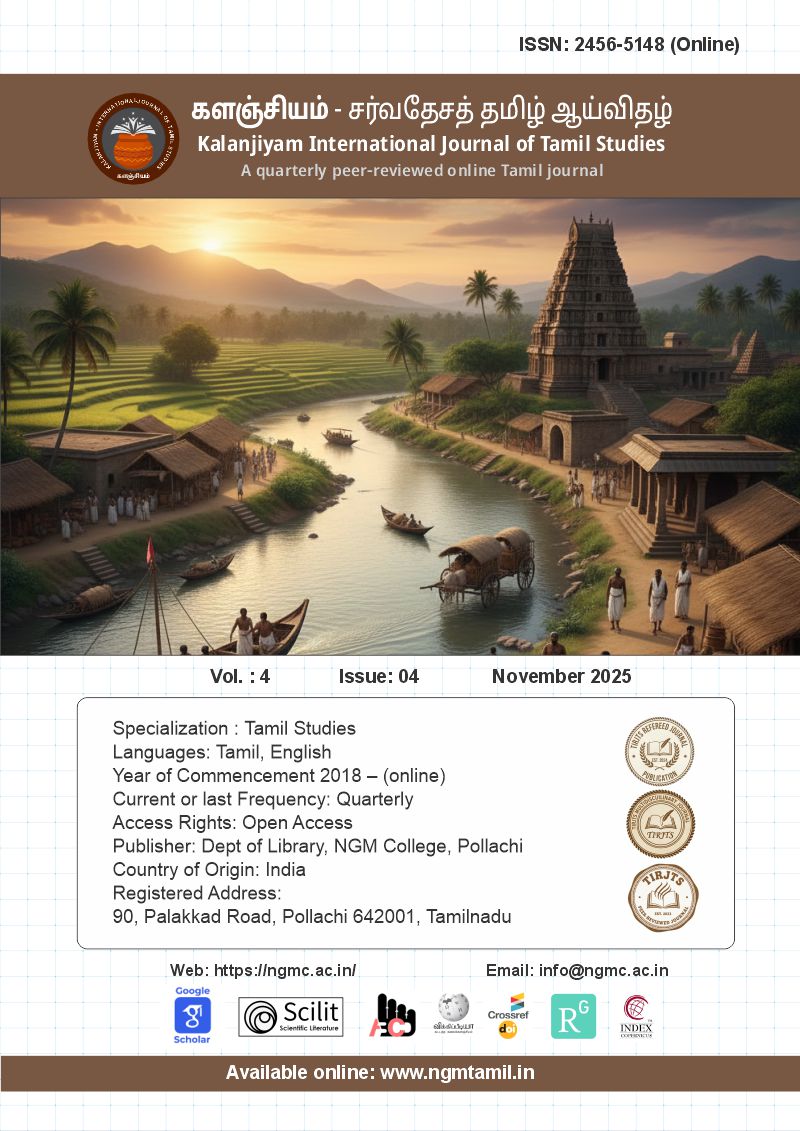தமிழ் மரபில் ஆற்றுப்படை இலக்கியங்களின் தோற்றுவாய்
The Genesis of Āṟṟuppaṭai Literature in the Tamil Tradition
Keywords:
Tamil Literature, Āṟṟuppaṭai (Guidance Literature), Ciṟṟilakkiyaṅkaḷ (Minor Literature), Sangam Literature, Literary Evolution, Marabu (Tradition), Cardinal VirtuesAbstract
Tamil literature stands as a monumental testament to linguistic richness, consistently generating diverse literary genres that reflect evolving societal contexts. Poets (pulavars) capture lived experiences, infuse them with imagination, and align them with the emotional currents of their time, thereby creating novel literary forms. This generative process is evident from the earliest Sangam texts, which sought to represent the entirety of human existence. Tamil literary tradition fundamentally established the hierarchy of life’s cardinal virtues—Aram (virtue), Porul (wealth), Inbam (pleasure), and Veedupetu (liberation)—as the central pillars of human endeavor. However, as philosophical emphasis shifted or as poets sought brevity and immediate impact, minor literary forms (Ciṟṟilakkiyaṅkaḷ) began to emerge. These shorter works facilitated the graceful exchange of meaning without diluting the literary essence, often drawing structural and thematic cues from earlier, monumental literary prototypes. The creative writer, while addressing contemporary socio-cultural dynamics, meticulously preserves the integrity of ancestral tradition (marabu) by foregrounding specific components of older literature to forge new classifications. The Āṟṟuppaṭai (Guidance/Directive literature)—an ancient and enduring genre—exemplifies this continuous synthesis. It is a form that accommodates temporal shifts and social progress, continuously modernizing its scope while retaining its core function. This article investigates the foundational origins (thōṟṟuvāy) of Āṟṟuppaṭai literature as situated within the broader context of Tamil literary evolution.
தமிழ்மொழியின் செழுமைக்குக் காரணமாகப் பல இலக்கிய வகைகள் காலத்திற்குக் காலம் தோன்றி வருகின்றன. புலவர்கள் தாம் கண்டுணர்ந்த அனுபவக் காட்சிகளின் மீது கற்பனையைப் புகுத்தி, சூழலுக்கேற்ற உணர்வோடு புதுமையான இலக்கிய வகைகளை உருவாக்குகின்றனர். மக்களின் வாழ்வியல் உணர்வைப் பிரதிபலிக்கும் சங்கப்பனுவல் தொடங்கி, பிற்கால மரபில் உதித்த பல இலக்கியங்களிலும் இப்போக்கு அமைந்திருப்பதைக் காணலாம். வாழ்வியலில் அறத்தை முதன்மைப்படுத்தி, அறத்தின் வழி பொருளீட்டி, இன்பத்தில் திளைத்து, வீடுபேறு அடையும் நிலையை உறுதிப்பொருளாகத் தமிழிலக்கியங்கள் வகுத்துக் காட்டியுள்ளன.
உறுதிப்பொருள்கள் நான்கினுள் ஒன்றோ பலவோ குறைந்து வரவும், புலவர் தாம் கருதியதை எளிதில் பொருட்சுவை மாறாது வழங்கவும் துணைநின்றவை சிறிய அளவில் படைக்கப்பட்டு நுகரப்படும் சிற்றிலக்கியங்கள் ஆகும். அச்சிற்றிலக்கிய வகையினுள் பல இலக்கிய வடிவங்கள் பிற்காலத்தில் தோன்றியுள்ளன. அவை முன்னைய இலக்கிய வடிவங்களின் சில முதன்மைக்கூறினை அடிப்படையாகக் கொண்டு புலவர்களால் படைக்கப்பட்டுள்ளன.
சமூக மாற்றத்திற்கும் தற்கால வாழ்க்கைச்சூழலுக்கும் ஏற்றவகையில் இலக்கியம் படைக்கும் படைப்பாளன் முன்னோர் மரபினைப் பேணி, அவ்விலக்கியத்தின் சில கூறுகளை முதன்மைப்படுத்திப் புதுமையான இலக்கிய வகையாக உருவாக்குகின்றான். பழந்தமிழ் இலக்கியத்தில் அமைந்த ஆற்றுப்படை இலக்கியம் மரபுவழி வந்த இலக்கிய வகையாக இன்றளவும் திகழ்ந்து வருகிறது. ஆற்றுப்படை காலமாறுதல்களைத் தன்னுள் புகுத்தி சமூக வளர்ச்சிக்குரிய நிலையில் புதுமைக்கும் இடமளித்து வருகிறது. அத்தகைய, ஆற்றுப்படை இலக்கியத்தின் தோற்றுவாய் தமிழ் இலக்கியங்களில் அமைந்துள்ள பாங்கினை ஆராய்வதாக இக்கட்டுரை அமைகிறது.
Downloads
References
Kanakasabapathy, A. “The Structure and Theme of Āṟṟuppaṭai in Classical Tamil Literature.” Journal of Tamil Studies, vol. 54, 2017, pp. 45–62.
Pillai, S. P. Manickam. The Four Cardinal Virtues in Tamil Tradition: Aram, Porul, Inbam, and Veedu. University of Madras Press, 2005.
Ramanujan, A. K., translator. The Interior Landscape: Love Poems from a Classical Tamil Anthology. Indiana University Press, 1967. (Represents the Sangam corpus).
Zvelebil, Kamil V. Tamil Literature. E.J. Brill, 1974.
Downloads
Published
Issue
Section
License

This work is licensed under a Creative Commons Attribution 4.0 International License.
Our journal adopts CC BY License Creative Commons Attribution 4.0 International License http://Creativecommons.org//license/by/4.0/ . It allows using, reusing, distributing and reproducing of the original work with proper citation.


